Lactobacillus levels and prognosis of patients with acute myocardial infarction
Jing-Jing CAI, Yin LIU, Jie WANG, Jing-Xian WANG, Yuan WANG, Shi-Bo XU,Zhuang CUI, Jing GAO?
1. Graduate School, Tianjin Medical University, Tianjin, China; 2. Department of Cardiology, Xing’anmeng People’s Hospital,Inner Mongolia, China; 3. Clinical School of Thoracic, Tianjin Medical University, Tianjin, China; 4. Department of Cardiology,Tianjin Chest Hospital, Tianjin, China; 5. School of Public Health, Tianjin Medical University, Tianjin, China; 6. Cardiovascular Institute, Tianjin Chest Hospital, Tianjin, China
ABSTRACT
With the aging of society and changes in life style, the incidence of acute myocardial infarction (AMI) is increasing year by year, which has become the main cause of death worldwide and poses a serious threat to human health.[1]Recently, however, the success rate of AMI rescue has significantly improved, and the rate of death and disability has decreased. The mortality of patients receiving percutaneous coronary intervention (PCI) and optimized drug therapy remain as high as 7% to 18% within one year.[2,3]New treatments to improve the prognosis and the quality of life of AMI patients are essential.
Recently, increased attention is being given to the relationship between gut microbiota and cardiovascular diseases.[4–6]Our previous study found that the abundance of Lactobacillaceae in the stool of acute coronary syndrome (ACS) patients was significantly decreased.[7]Also, animal experiments have confirmed that Lactobacillus has the effects of antiinflammation, regulating blood lipids and improving cardiac injury after myocardial infarction (MI).[8–10]Therefore, we speculated that the level of Lactobacillus may be associated with the prognosis of patients with AMI.
The purpose of this study was to quantitatively analyze the association between Lactobacillus and outcomes of AMI patients treated by emergency PCI, as well as the relationship between Lactobacillus and inflammation, myocardial injury and other biomarkers, and to evaluate the effect of Lactobacillus on long-term prognosis to provide new ideas for early and long-term clinical intervention.
METHODS
Study Population
In this prospective cohort study, we collected the data of AMI patients who received emergency PCI treatment in the coronary care unit of Tianjin Chest Hospital in China from July 2017 to December 2018.All patients, aged between 20 years and 85 years,were residents of Tianjin. The diagnosis and treatment of AMI were performed according to the guideline recently published.[11]Patients with previous organic lesions of digestive system, cancer, previous MI, and previous coronary artery bypass grafting were excluded. Individuals were also excluded if they had infectious and inflammatory disorders,had received antibiotics or probiotics, were taking proton pump inhibitors or hormone-replacement therapy within the last two months. Finally, 254 patients were included (Figure 1). A total of 192 patients had ST-segment elevation MI (STEMI) and 62 patients had non-ST-segment elevation MI (NSTEMI).The fecal samples of all patients were collected and sent out to extract bacterial DNA. All AMI patients had taken aspirin prior to primary PCI. This study was conducted in accordance with the Declaration of Helsinki (as revised in 2013). The study protocol was approved by the Ethics Committee of Tianjin Chest Hospital (No.2018KY-010-01) and signed informed consent was provided by all included patients.
Data Collection and Group Definitions
Subjects’ baseline data, such as demographic characteristics, medical history, family history, physical activity, smoking status, alcohol consumption,test results, echocardiography and interventional treatment records, were collected through the clinical electronic medical record system. Blood samples and fresh stool samples were collected immediately after emergency PCI surgery or the next morning.The whole blood samples were centrifuged at 4 °C,3,000 r/min for 10 min and the supernatant (serum or plasma) was cryopreserved at ?80 °C for later testing. Fresh stool samples (> 300 mg) were placed into a sterile, externally-circulated cryotube that was sealed and stored at ?156 °C.
Detection of Lactobacillus by SYBR Green II Realtime Fluorescence Quantitative PCR
After bacterial DNA was extracted from stool samples, Lactobacillus was tested for PCR reaction.The amount of Lactobacillus in feces was detected by SYBR Green II real-time fluorescence quantitative PCR. The reaction primers were designed according to previous studies and synthesized by Thermo Fisher Science Co.Ltd.[12–15]The primer sequences were as follows: Lac-F: 5’-AGCAGTAGGGAATCTTCCA-3’ and Lac-R: 5’-CACCGCTACAC ATGGAG-3’. The reaction reagent is from TB Green? Premier Ex Taq? II (Tli RNaseH Plus). The reaction system was Real Master Mix: 10 μL, upstream and downstream primers 0.8 μL, ROX II 0.4 μL, template DNA 2 μL, DEPC water 6 μL, and the reaction volume was 20 μL. Reaction conditions were: pre-denaturation at 95 °C for 5 min, denaturation at 95 °C for 15 s,annealing at 58 °C for 34 s, elongation at 72 °C for 60 s, and cycled 40 times. In each experiment, standard calibration and a negative control of sterilized water were set up at the same time. After the reaction, the specificity of PCR products was analyzed according to the fusion curve. According to the fluorescence data, the Ct value was analyzed automatically by the 7500 System SDS Interface Software and the standard curve was generated.
Evaluation of Clinical Outcomes
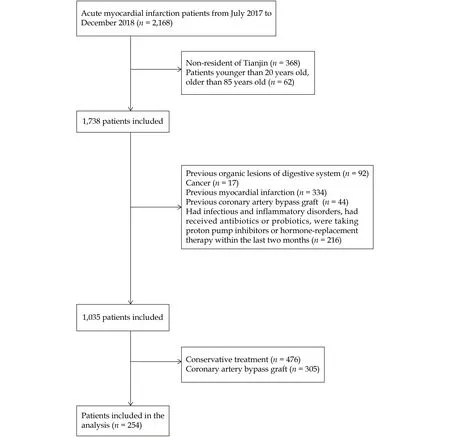
Figure 1 Study protocol.
Prospective follow-up was carried out by clinic visits or telephone interviews at 6 months, 12 months,24 months and 30 months from the date of selection.The staff regularly followed up the AMI patients and urged them to visit the myocardial infarction clinic on time according to the study plan. Outpatient physicians give professional technical guidance to the changes of the disease, perform necessary laboratory and imaging examinations, and provide the best treatment measures. The occurrence of a first major adverse cardiovascular event (MACE)was judged independently by senior cardiologists,and was regarded as the follow-up endpoint. MACE included cardiac death, stroke, recurrent MI, target lesion revascularization, and hospital admission for heart failure (HF).
Interim Quality Control
The work was carried out by a professional followup team (including senior cardiologists, nurses and data managers) in accordance with the standardized guidelines and manuals for AMI. Follow-up personnel unified training, assessment to take up the post. Each patient received health education and issued a follow-up manual when he was discharge from the hospital. The clinical data were entered into the AMI patients management center by an electronic data capture system, and the supervisors check the original data regularly to ensure the authenticity and integrity of the data. Endpoint events were independently judged by senior cardiologists according to the “endpoint criteria” defined by the study protocol.
Statistical Analysis
According to the Lactobacillus content in our previous study[7]and the incidence of MACE, which was 7% to 18% after PCI,[2,3]and assuming a 20% of drop-out rate, a total of 26 participants are required to provide 90% power, with a two-sided type I error of 0.05. Considering the need to explore the risk of MACE in different subgroups of patients, we included more subjects to ensure a sufficient number of endpoint events.
X-tile analysis, developed for biomarker cut-point selection in survival scenario by Camp RL,et al.,[16]was performed to categorize Lactobacillus into lowlevel, medium-level and high-level. X-tile analysis takes both Lactobacillus level and composite MACE of patients into consideration when choosing cut-off point, so it can ensure survival homogeneity within groups and heterogeneity between groups as much as possible.[16]Description statistics for continuous variables are mean ± SD or medians (interquartile range) as appropriate according to its distribution,counts (percentages) are given for categorical variables. For group comparison, Wilcoxon rank tests and Wald-type Chi-squared tests were used dependent on their distribution to examine the difference between groups. Spearman correlation analysis and trend test were used to evaluate the correlation between Lactobacillus and clinical indicators. The relationship between Lactobacillus level and prognosis of AMI patients was analyzed by univariate and multivariable Cox regression analysis. The variables withP-value less than 0.1 in univariate analysis and considered clinically meaningful were included in the multivariate regression analysis. Kaplan-Meier curve was graphed for MACE-free survival time of patients by Lactobacillus levels.P-value < 0.05 indicated that the difference was statistically significant. Basic statistical analyses were conducted with SPSS software 25.0 (SPSS Inc., IBM, Armonk, NY,USA) and R software 3.6.2 (http://www.r-project.org/). X-tile analysis was performed using X-tile software 3.4.7 (Copyright Yale University, Cambridge, MA, USA).
RESULTS
PCR Results
A 1 × 109?1 × 101copies figure of the relationship between the cycle number of the template and the fluorescence intensity can be obtained from the realtime fluorescence quantitative PCR reaction carried out after the standard sample was diluted 10 times(Figure 2A). Figure 2A reveals that with the increase of the cycle numbers of the templates with different copies, the fluorescence intensity increases gradually, and the curve tends to be parallel after a period of exponential expansion, that is, the “platform period”. The standard curve of Lactobacillus was obtained by taking the logarithm of the standard sample with different copy number as the abscissa and the initial cycle number (Ct value) that reached the fluorescence threshold in the process of quantitative PCR reaction as the ordinate, which provided a reference standard for the quantification of the samples to be tested (Figure 2B). The analysis of the melting curve after each PCR reaction showed that the melting curve was a single peak, which indicated that the amplification product was single. That was the target DNA fragment, which avoided the occurrence of false positive results in the process of quantitative PCR detection (Figure 2C).
Cut-off Point Selection of Lactobacillus
All patients were divided into low level (≤ 3.6 copies/g), medium level (3.6?7.1 copies/g) and high level (> 7.1 copies/g) of Lactobacillus using Xtile analysis (supplemental material, Table 1S and Figures 1S–3S).
Characteristics of Study Population

Figure 2 PCR results of Lactobacillus. (A): The amplification curve of Lactobacillus; (B): the standard curve of Lactobacillus; and (C):the fusion curve of Lactobacillus.

Table 1 Baseline characteristics of patients by Lactobacillus concentration.
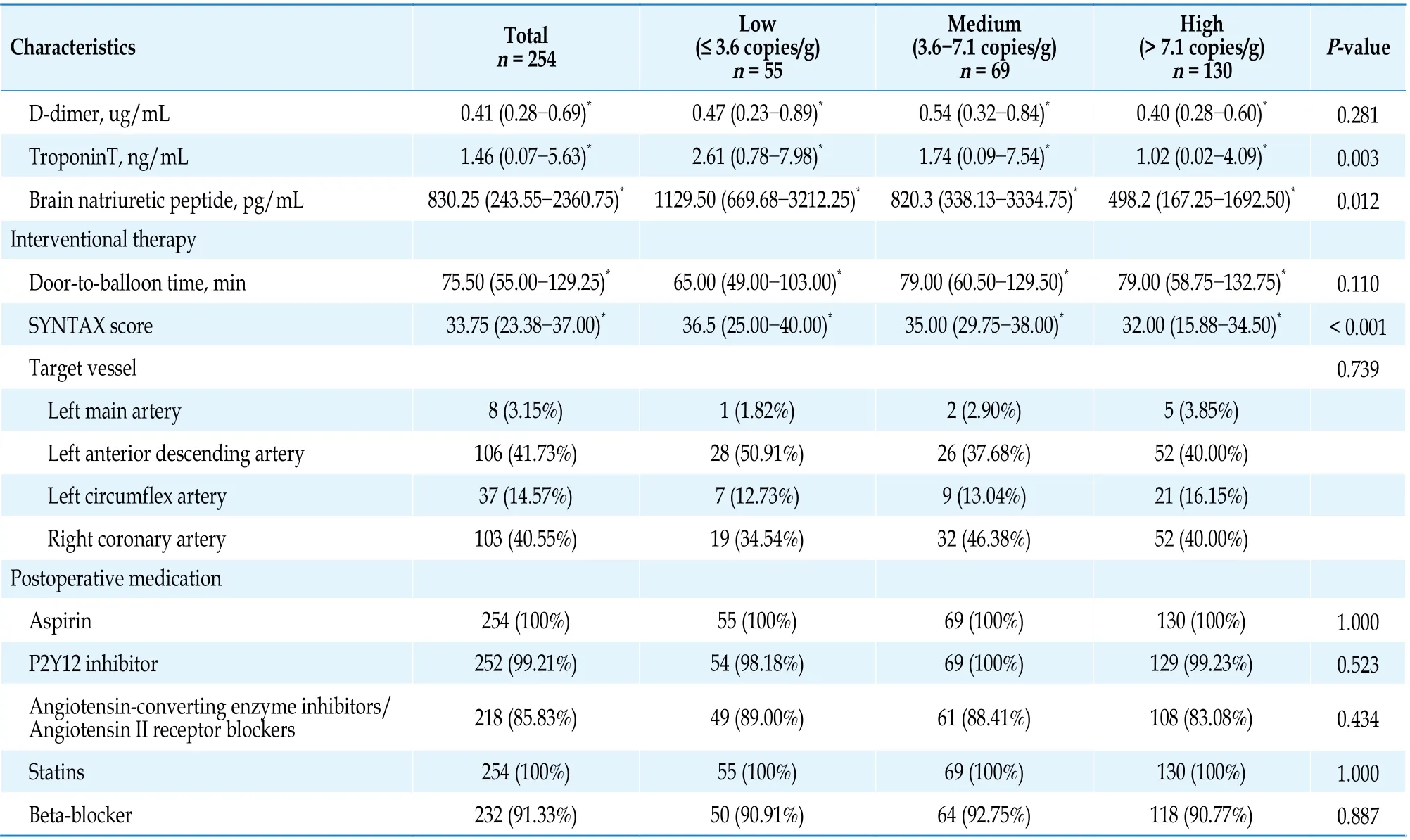
Continued
A total of 254 AMI patients who received PCI treatment were enrolled. Baseline characteristics of patients were stratified according to Lactobacillus level, as shown in Table 1. Mean age was 65.90 ±11.56 years, about 59.84% of patients were males,and 51.18% of patients were smokers. No statistically significant differences were found in gender,age, medical history and postoperative medication among the three groups (P> 0.05). The levels of white blood cells (WBC), neutrophils (NEUT), highsensitivity C-reactive protein (hs-CRP), TroponinT(TNT), creatine kinase (CK), creatine kinase-MB(CK-MB), brain natriuretic peptide (BNP), apolipoprotein B (apoB), total cholesterol (TC) and left ventricular ejection fraction (LVEF) were significantly different among the three groups (P< 0.05), while no statistically significant differences in platelets,low-density lipoprotein (LDL), triglycerides (TG), Ddimer levels, door-to-balloon time and target vessel distribution were found among the three groups.Compared with the low-level Lactobacillus group,the levels of WBC, NEUT, hs-CRP, TNT, CK, CK-MB and BNP were significantly lower in the high-level Lactobacillus group, while the LVEF values were higher.
The details grouped by disease types shown in supplemental material, Table 2S. Compared with NSTEMI patients, the levels of WBC, NEUT, CK, CKMB, hs-CRP, TNT and BNP were significantly higher in STEMI patients, while the levels of apolipoprotein A, high-density lipoprotein (HDL), Lactobacillus and LVEF values were lower (P< 0.05). There were no significant differences in gender, age, smoking history, medical history and postoperative medication among the two groups (P> 0.05).
Analysis of the Correlation Between Lactobacillus and Biomarkers
Spearman correlation analysis showed that Lactobacillus correlated negatively with WBC, NEUT, hs-CRP, CK, CK-MB, TNT and BNP, but correlated positively with LVEF (Figure 3A). The results of trend tests showed that with increasing Lactobacillus levels, the levels of WBC, NEUT, hs-CRP, CK,CK-MB, TNT and BNP decreased, while LVEF increased gradually (Ptrend< 0.05) (Figure 3B). In STEMI patients, the results of trend tests showed that with increasing Lactobacillus levels, the levels of WBC, NEUT, hs-CRP, CK, CK-MB, TNT and BNP decreased (Ptrend< 0.05). No similar association was found in NSTEMI patients. The correlation between Lactobacillus levels and TC, TG, HDL,LDL, apolipoprotein A and apoB were not found in both STEMI patients and NSTEMI patients, as shown in Table 2.
Follow-up and Outcomes
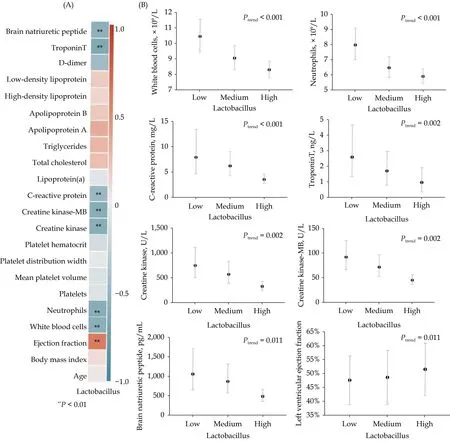
Figure 3 The correlation between Lactobacillus and biomarkers. (A): Correlation analysis between Lactobacillus and biomarkers(the red and blue blocks represent positive and negative correlations, respectively); and (B): trend test of the relationship between Lactobacillus and biomarkers.
The follow-up time was 652 (548.25?753.00) days,and nine patients were lost to follow-up. The baseline characteristics of patients grouped by the occurrence of MACE shown in Table 3. Patients experiencing MACE were older (65.03 ± 11.34vs.69.82 ±12.41,P= 0.021), and also had higher hs-CRP levels[4.05 (1.52?10.65)vs.8.81 (2.34?39.06),P= 0.008]and BNP levels [708.90 (198.20?1938.75)vs.1461.00(555.90?4662.00),P= 0.001], and lower Lactobacillus levels than those without MACE [4.55 (3.16?6.80)vs.7.77 (4.63?10.59),P< 0.001]. No statistically significant differences were found in gender, medical history and postoperative medication among the two groups (P> 0.05).
A total of 45 patients (18.36%) experienced at least one MACE, including 14 patients (5.71%) experienced cardiac death, 14 patients (5.71%) were hospitalized for HF, 6 patients (2.45%) experienced non-fatal recurrent MI, 5 patients (2.04%) experienced target lesion revascularization and 6 patients(2.45%) experienced stroke.
Relationship of Lactobacillus Levels and Outcomes
The results of multivariate Cox regression analy-sis indicated that compared with the low Lactobacillus level group (≤ 3.6 copies/g), the risk of MACE was significantly lower in patients with high levels(> 7.1 copies/g) of Lactobacillus [adjusted hazard ratio (HR) = 0.216, 95% CI: 0.094–0.493,P< 0.001]. Subgroup analysis classified by MI types showed that this difference was statistically significant in patients with STEMI (HR = 0.217, 95% CI: 0.085?0.551,P= 0.001), as shown in Table 4. Lactobacillus significantly reduces the risk of MACE in STEMI patients receiving PCI treatment, and improves the longterm prognosis of patients (Figure 4). The results of subgroup analysis indicated that high level of Lactobacillus was a protective factor for male patients who smoked, who were older than 60 years and whose BNP was over 1,000 pg/mL (the best cut-point of BNP was obtained by X-tile analysis), as shown in Figure 5.

Table 2 The relationship between Lactobacillus and biomarkers.
DISCUSSION
We gained an understanding of the structure and diversity of gut microbes in ACS patients through the preliminary high-throughput sequencing, and found that the abundance of Lactobacillaceae in feces of ACS patients was significantly reduced. Based on this understanding, we investigated the effects of Lactobacillus on the clinical parameters and prognosis of AMI patients. Results of the present study showed that the probiotic Lactobacillus significantly reduced the risk of MACE and improved the outcomes of patients with AMI. Subjects with higher Lactobacillus levels had a lower risk of MACE (HR =0.216, 95% CI: 0.094?0.493,P< 0.001), noted especially in STEMI patients (HR = 0.217, 95% CI: 0.085?0.551,P< 0.001).
At present, most studies have focused on the high-risk factors leading to MI, such as hypertension,diabetes mellitus, smoking, and so on, while ignoring the damage that may affect AMI-related outcomes, such as inflammation, myocardial injury, etc.Inflammation plays an integral role in the occurrence and development of AMI. After AMI, gut barrier breakdown occurs due to the weakened heart pumping function and insufficient intestinal perfusion, bacteria and endotoxin translocation into the systemic circulation, and immune-inflammatory system activation. The inflammatory response induced after MI can repair the heart while also causing cardiac remodeling and cardiac insufficiency,increasing the risk of cardiovascular events after MI.Previous study has shown that inflammatory markers can predict the prognosis of MI.[17]

Table 3 Baseline characteristics for MACE analysis.

Table 4 Univariate and multivariate Cox regression of the association between Lactobacillus and major adverse cardiovascular event.

Figure 4 Kaplan-Meier survival curve of the associations between the risk of MACE and Lactobacillus levels. (A): Kaplan-Meier survival curve of total patients; (B): Kaplan-Meier survival curve of STEMI patients; and (C): Kaplan-Meier survival curve of NSTEMI patients. MACE: major adverse cardiovascular event; NSTEMI: non-ST-segment elevation myocardial infarction; STEMI: ST-segment elevation myocardial infarction.
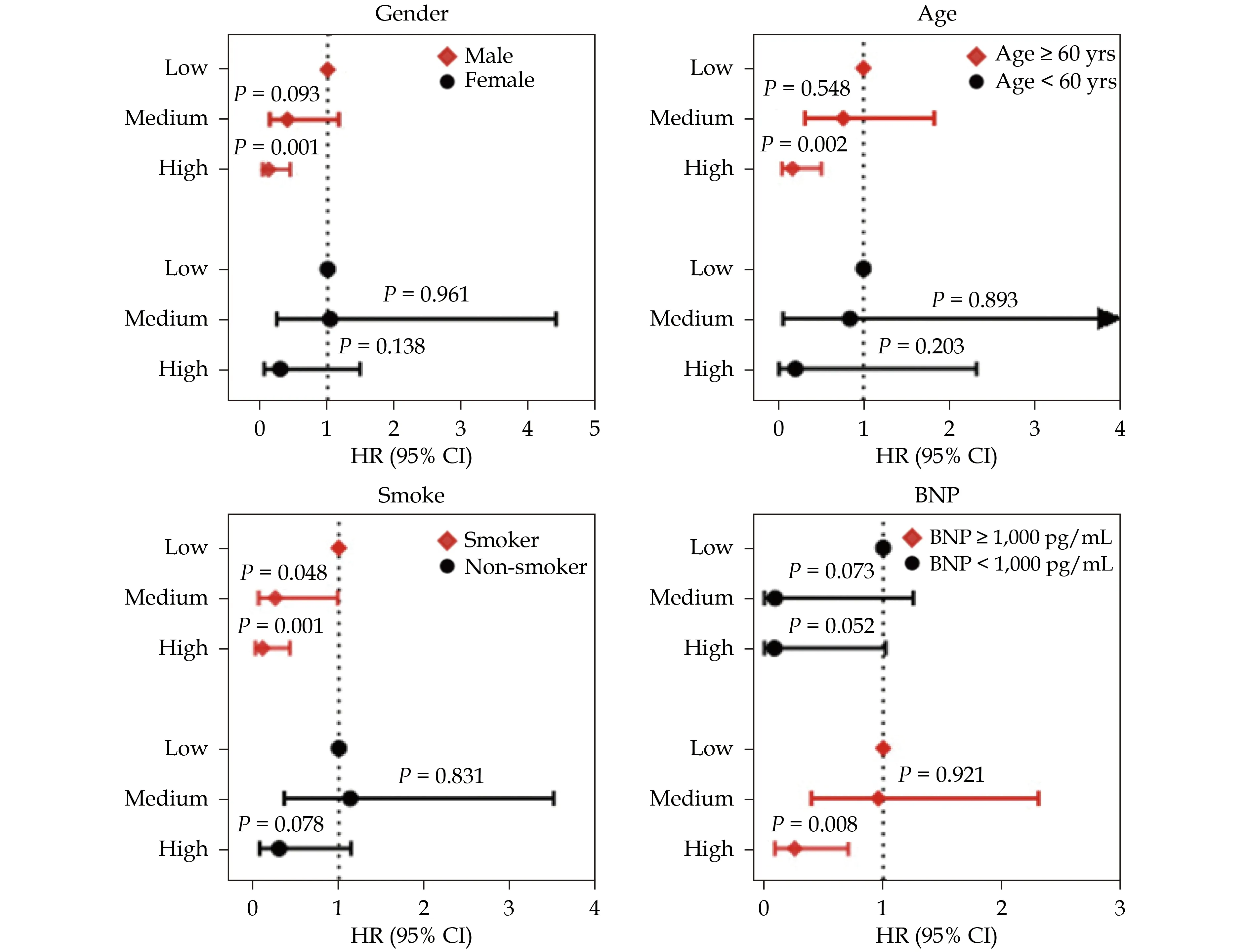
Figure 5 Subgroup analysis in different ST-segment elevation myocardial infarction patients. Subgroups, across different genders,ages, smoking or not and BNP levels, display adjusted HR (95% CI) from multivariate Cox regression model. BNP: brain natriuretic peptide; HR: hazard ratio.
WBC have the function of phagocytosis, and can secrete a variety of factors and participate in inflammation and immune response. Studies have shown that hospital mortality and short-term mortality of AMI increase with increases in the WBC count baseline. WBC count and neutral increase can be used as predictors of AMI mortality.[18]Wang Y,et al.[19]showed that the one-year MACE risk ratio of AMI patients with WBC > 12 × 109/L was 2.65. hs-CRP is one of the most powerful predictors of cardiovascular disease. In the process of AMI, a large amount of interleukin 6 is released from the infarcted area to stimulate the production of CRP. A global multicenter study confirmed that hs-CRP of patients with ACS were independently associated with MACE,cardiac death and all-cause death.[20]Reducing the inflammatory response after MI can improve the prognosis. Gut bacteria are approximately populated by 1,014 microbes, and opportunistic pathogens at 109.[21]Lactobacillus is a type of probiotic with anti-inflammatory effects. Previous animal experiments have demonstrated that Lactobacillus has anti-inflammatory properties.[9]Lactobacillus can regulate trimethylamine N-oxide level and CD4+T cell induced-type I inflammation.[22]The present study found that the risk of MACE was significantly lower in STEMI patients with high levels of Lactobacillus, but no similar protective association was observed in NSTEMI patients. It may be related to the pathogenesis of STEMI and NSTEMI. The rupture mechanism of vulnerable plaques is more common in STEMI patients, which is often associated with local and systemic inflammation and the formation of red thrombus resulting in significant narrowing or even complete occlusion of the lumen.In recent years, with the application of endoluminal imaging, it has been found that NSTEMI patients have more plaque erosion mechanisms, and this type of inflammatory cell infiltration is less, forming platelet-rich white thrombosis.[23,24]Our study found that the inflammatory response in STEMI patients was more pronounced than that in NSTEMI patients, hs-CRP levels [5.77 (2.61?21.82)vs.1.54(0.61?4.11),P< 0.001], WBC [9.78 (7.80?12.13)vs.6.75 (5.54?7.57),P< 0.001], NEUT [7.36 (5.78?9.73)vs.4.18 (3.32?5.13),P< 0.001], and the WBC count,absolute value of NEUT and hs-CRP decreased gradually as Lactobacillus levels increased. Lactobacillus may affect patients’ prognosis by improving the inflammatory response after STEMI. Of course,our study was a single-center clinical study, and more large-sample, multi-center clinical and basic studies may be needed in the future to further clarify the protective effect of Lactobacillus on AMI and its mechanism. So as to provide a new target for the prevention and treatment of AMI.
Myocardial enzyme and troponin, as important biomarkers of myocardial injury, play an important role in the monitoring and prognosis of patients with AMI. The experimental results of Wang N,et al.[25]showed that the serum CK and infarct area decreased significantly in the ischemia reperfusion rat model treated with Lactobacillus. Lactobacilli play a cardioprotective effect through the antioxidant pathway mediated by nuclear factor erythroid 2-related factor 2.[26]Results of the present study also showed that CK, CK-MB and TNT in the high Lactobacillus level group were still significantly lower than those in the low Lactobacillus level group. Furthermore, with the increasing of Lactobacillus, TNT,CK and CK-MB showed a downward trend. Lactobacillus may reduce the mortality and disability rate and improve the prognosis of patients by alleviating myocardial injury.
BNP is synthesized and secreted by ventricular cells, which reflects the degree of ventricular pressure and cardiac function damage. As such, BNP is an important biomarker of myocardial ischemia,and it has significant clinical value in the diagnosis of cardiovascular disease and the evaluation of cardiac function. LVEF reflects patients’ cardiac pump function and provides a useful prognostic index of AMI. The present study found that the level of Lactobacillus correlated positively with LVEF and negatively with BNP. With increasing Lactobacillus levels, the value of LVEF gradually increased, while BNP showed a downward trend. Lactobacillus may reduce the risk of adverse events such as HF by improving cardiac pump function in patients with AMI.
Previous animal experiments showed that Lactobacillus regulated lipid metabolism disorder by inhibiting the expression of fatty acid synthase and acetyl-CoA carboxylase in the liver of obese mice,reducing the contents of TC, TG, LDL, and increasing the content of HDL in the serum of obese mice.[27]A randomized controlled study showed that treatment with Lactobacillus plantarum Q180 for 12 weeks significantly decreased LDL and apoB-100 levels.[28]Jones ML,et al.[29]also showed that Lactobacillus reuteri NCIMB 30242 significantly reduced LDL, TC, apoB-100 and non-HDL. However, our study did not find the correlation between the level of Lactobacillus and lipids (Figure 3). Consider differences in lipid levels between STEMI patients and NSTEMI patients. We further explored the relationship between Lactobacillus levels and lipids in patients grouped by disease type. The results showed that the correlation between Lactobacillus levels and TC, TG, HDL, LDL, apolipoprotein A and apoB were not found in both STEMI patients and NSTEMI patients (Table 2). The lipid metabolism mechanism is complex, and Lactobacillus may be involved,but the present study did not find a linear correlation between Lactobacillus and lipid metabolism,which may be associated with the study population.Previous animal or human trials were based on healthy individuals. However, the present experiment was the first study to explore the relationship between Lactobacillus and blood lipid levels in AMI patients. Whether Lactobacillus can improve the prognosis of AMI patients by affecting lipid metabolism and its possible mechanism may require using larger samples and multicenter clinical and basic trials to verify results of the present study.
LIMITATIONS
There are several limitations that must be noted.Firstly, the study was based on the results of longterm follow-up of a single center, and all subjects were AMI patients from coronary care unit. This means that the conclusion may be limited in extrapolation of results to other populations, and results still need to be verified by a larger-scale multicenter, prospective cohort study. Secondly, no dietary restrictions were imposed on the subjects in this study, and dietary structure and lifestyle may have a certain impact on the results. But studies have demonstrated that in healthy subjects, intersubject variability is greater than temporal variability in individuals.[30]The study of Aho VTE,et al.[31]shown that the differences in gut microbiota of Parkinson’s disease patients and controls persist at follow-up sampling two years later. Of course, it is anticipated to determine whether not only the real-time gut microbiota level but the time-dependent gut microbiota level is associated with prognosis in AMI patients. If so, the change of gut microbiota level will provide more detailed evidence of causation with progress and outcomes of AMI. Last but not least, by analyzing the correlation between clinical indexes and the level of Lactobacillus, we found that Lactobacillus was closely associated with the inflammatory response and myocardial injury after MI. It may be possible to regulate the inflammation and myocardial injury via probiotics supplementation, which may improve the prognosis of AMI patients. Nevertheless, more cellular and molecular biology and animal experiments are needed to further elucidate the exact mechanism.
CONCLUSIONS
The present study reveals for the first time the correlation between Lactobacillus, inflammation and myocardial damage after MI. STEMI patients with high levels of Lactobacillus have better outcomes, especially male smokers over 60 years with severe impairment of cardiac function. Results of this study suggest new therapeutic strategies for improving the prognosis and quality of life of AMI patients.
ACKNOWLEDGMENTS
This study was supported by the Key Project of Scientific and Technological Support Plan of Tianjin in 2020 (No.20YFZCSY00820), the Major Science and Technology Projects of Tianjin Science and Technology Commission in 2016 (No.16ZXMJSY00150),and the Key Project of Healthcare Industry of Tianjin in 2016 (No.16KG131). All authors had no conflicts of interest to disclose. The authors wish to thank the Novogene Bioinformatics Technology Co. Ltd for providing sequencing analysis of the microbial genome, the Tianjin Chest Hospital Biobank for providing standardized frozen stool specimens, and especially thank the patients for their participation in the study.
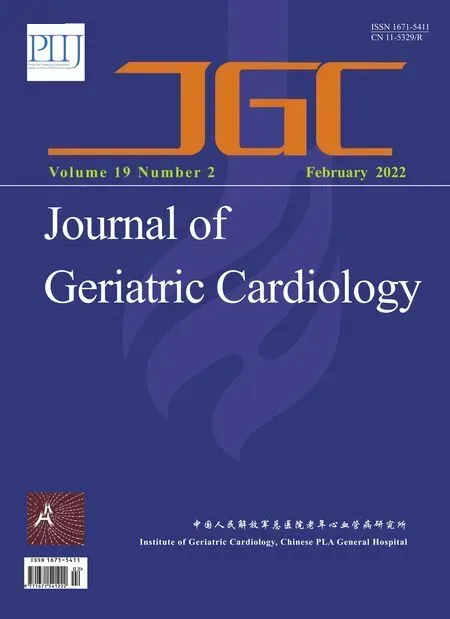 Journal of Geriatric Cardiology2022年2期
Journal of Geriatric Cardiology2022年2期
- Journal of Geriatric Cardiology的其它文章
- Usefulness of Impella support in different clinical settings in cardiogenic shock
- Translational proteomics in cardiogenic shock: from benchmark to bedside
- Challenges in the conduct of randomised controlled trials in cardiogenic shock complicating acute myocardial infarction
- Mechanical circulatory support in cardiogenic shock and postmyocardial infarction mechanical complications
- Cardiogenic shock due to left main related myocardial infarction:is revascularization enough?
- The characteristic and dynamic electrocardiogram changes on hyperkalemia in a hemodialysis patient with heart failure:a case report
